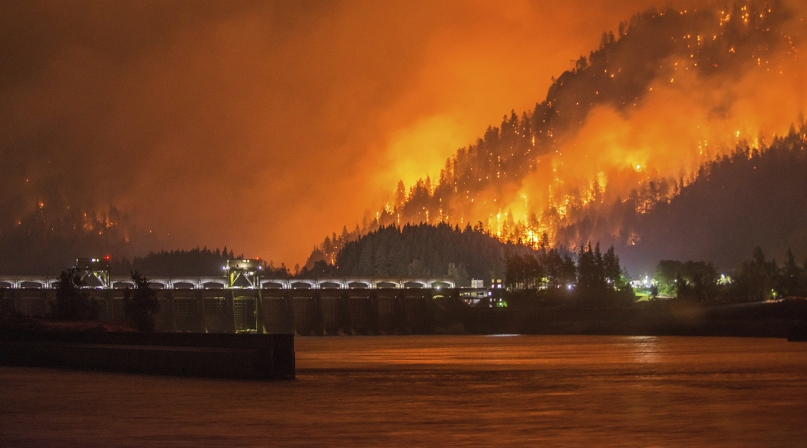Wildfires put lives, health, ecology, property values at risk

Wildfires pose question of long-term heart and lung health in affected counties
A dry summer has led to a spate of Western wildfires that county officials worry will affect health conditions and economic viability for years. And they have not been relegated to rural areas — the Columbia River Gorge went up in flames, bringing smoke into the city of Portland, Ore.
The wildfire risk jumped exponentially after a snowy winter, ice storms and a wet spring fueled the growth of underbrush and tall grass that subsequently withered as the weather turned dry over the summer. The Pacific Northwest, known for its regular precipitation and mild climate, baked in 90-degree to 100-degree weather exacerbating wildfire risk.
Learn More
The Eagle Creek Fire in Oregon was sparked Sept. 2 when a teenager reportedly threw a smoke bomb into the woods of Hood River County. Overnight, it grew to 3,000 acres into Multnomah County. By Sept. 12 it had grown to more than 35,000 acres and engulfed one of Oregon’s ecological treasures and forced the evacuation of hundreds of residents in western Hood River County and eastern Multnomah County. On Sept. 4, embers had floated across the milewide Columbia River, and the fire jumped into Skamania County, Wash.
“We live in a wind tunnel that is packed with fuel,” said Skamania County Commissioner Bob Hamlin. “It was a 95-degree day, with no humidity, the conditions were ripe for a wildfire.”
The Portland area had gone more than 90 days without a soaking rain, making a particularly dry environment for a fire.
“It was scary situation because east winds have a history of causing the strongest fires in our area,” Hamlin said. “You think of a fire break as being nothing more than a fire cut through with a bulldozer. This jumped a river almost a mile wide.”
Residents reported 16-inch embers falling from the sky. Interstate 84 has been closed, though the Columbia River-side westbound lanes may reopen.
“This is a fire that will still be burning underground, in the root systems and stumps, until December. Big wildfires like this don’t go out until snow is on the ground.”
Montana Fires Break Records
Since July 15, western Montana has had a series of fires that have consolidated their smoke around the Bitterroot Valley of Ravalli County. That’s starting to wear on residents who have had to move their outdoor activities elsewhere, including youth sports, and residents with respiratory conditions have been encouraged to leave. Fewer than 1,000 people have left their homes. Lightning strikes have lit fires in trees that have died from pine bark beetle infestations.
“We’ve spent more time on unhealthy to hazardous air quality that any time I can remember,” said Commissioner Greg Chilcott. “These fires that used to be just ground fires are now crown fires. They’re very destructive and exponentially larger than they have been in the past.”
Throughout the 20th century, 295,000 acres of Ravalli County forests burned in wildfires. In the first 15 years of the 21st century, 897,000 acres have burned.
“It’s an unenviable trend,” Chilcott said. “But I guess it means we’re running out of forest to burn.”
And it’s hell for local property values.
“People buy real estate in the Rocky Mountains because they want those beautiful mountain views,” Chilcott said. “Now they’re just seeing a charred moonscape.”
The fires have meant the county’s volunteer fire departments have pitched in to help federal and state firefighters. The sheriff’s office assists with evacuations, road closures and other needs and the roads department is often tasked with cleaning up.
The Seattle area isn’t on fire, but it has been dealing with the smoke from fires in British Columbia in August, and in September from other parts of Washington, plus Oregon and California. Like Portland, it has gone most of the summer without significant rainfall.
Phil Swartzendruber, an air quality scientist with the Puget Sound Clean Air Agency, which covers King, Kitsap, Pierce and Snohomish counties, said the fires have meant two distinct problems for residents.
“The effect people can most relate to are the more immediate tangible effects, burning eyes, coughing, irritation of the throat,” he said. “That’s not the big health concern. The big health concern is fine particulate matter that penetrates deep into the lungs and increases risk of cardiovascular disease including heart attacks and stroke. It can affect lung development in children, and exacerbate risk of asthma for other folks.”
He compared a five-days stretch of fine particulate matter levels well above the acceptable standard throughout the region as comparable to what you would see very localized in the winter from wood burning stoves.
“There are lot of variabilities as to where the fires are and how the smoke is moving up here, so it’s hard to tell exactly what we’re dealing with and what to expect (in regards to fine particulate matter),” Swartzendruber said.
At one point, white ash fell overnight, covering the area like a thick layer of spring pollen.
“That kind of stuff, you won’t breathe it in — it will be caught in your nose and throat,” he said. “We’re just really just hoping for rain.”
Outside of Yosemite National Park, Mariposa County, Calif., has had to evacuate its county seat of Mariposa for the first time in history after a fire split.
Supervisor Kevin Cann, who serves as the Western Interstate Region’s second vice president, said most of the nearby fires have been caused by carelessness.
“People parking in tall grass, forgetting how hot a catalytic converter gets,” he said. “Usually that grass is 6 inches tall. Thanks to the snow we had, it’s 3 feet, but now it’s dead and brown.”
Also, people shooting steel-coated bullets, which spark, on Bureau of Land Management land have lit a few fires.
On top of county efforts by the sheriff’s office and public works department — which means delaying planned projects — the human services department is providing assistance to more than 500 residents who lost property in the fires.
“The entire sheriff’s office is diverted to secure the houses when you have 5,000 people evacuated,” he said. “It’s a tremendous responsibility.”
Cann worries that the increasing frequency of wildfires will make it hard for homeowners to insure their properties, which will exacerbate the housing shortage in his county.
“These fires are not so much an inconvenience for park visitors as they are for the service economy workers who live here,” he said. “When neighborhoods full of three-bedroom houses are evacuated, those people have to live somewhere in the meantime, because they still have to work.”
Behind nearly every story of how a county deals with wildfires is the root cause many officials point to — dense growth in federal and some state forests, which have left residents and local governments at the mercy of nature.
Hamlin sees the Eagle Creek Fire’s silver lining in the smoke’s impact on the nearby cities.
“It sent a lot of smoke into Portland-Vancouver area,” he said. “I think it made a lot of people, who are complacent about the issue of wildfires, wake up to the fact that these out there, they’re real and they’re going to affect us.”
Chilcott sees, in his dense nearby forests, the same buffet that attracted pine bark beetles that killed the trees that eventually become fuel for fires. “Our forests are basically in an unhealthy state,” he said.
While NACo and WIR prioritize active forest management practices, Chilcott acknowledges that it’s a complicated topic.
“I think our federal agencies would be happy to actively manage forests, but there are a lot of regulatory barriers to projects getting off the ground,” he said, specifically the Endangered Species Act and the National Environmental Policy Act. “Active management is almost an impossibility until they reform those acts.”
Attachments
Related News

CMS issues new guidance on Medicaid Community Engagement Requirements
On December 8, the Centers for Medicare & Medicaid Services (CMS) released a Medicaid and CHIP Services Informational Bulletin (CIB) directing states on how to implement the Medicaid community engagement requirements enacted under Section 71119 of the One Big Beautiful Bill Act legislation (Public Law 119-21), or H.R. 1.

California county sales tax measure backfills federal healthcare cuts
Santa Clara County, Calif. will raise an estimated $330 million each year from a sales tax to backfill lose Medicaid funding.

